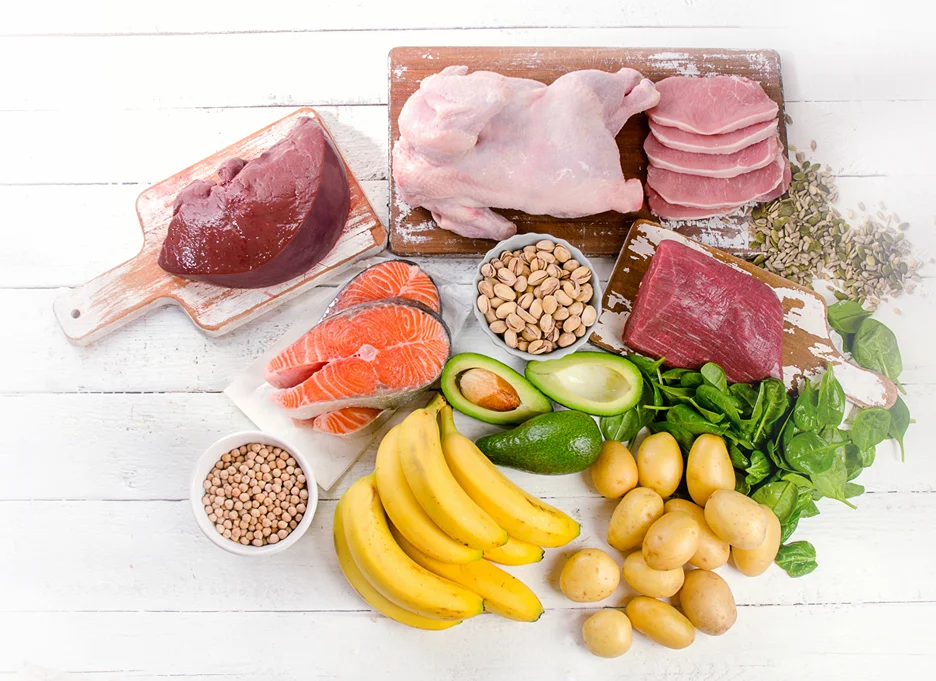Histamine intolerance can be a frustrating and perplexing condition, with symptoms ranging from skin rashes and digestive issues to headaches and respiratory difficulties.
If you’re one of the many individuals seeking relief from histamine-related symptoms, then exploring the world of diamine oxidase (DAO) precursors might hold the key to improving your well-being.
In this comprehensive guide, we’ll dive into the fascinating realm of DAO precursors and their potential to support histamine metabolism. We’ll unravel the science behind histamine intolerance, understand the role of DAO, and explore how incorporating DAO precursors into your diet may help alleviate symptoms and promote better health.
When Does Histamine Intolerance Happen?
Histamine intolerance occurs when the body’s natural histamine breakdown process is compromised. Histamine, a compound involved in immune responses and various physiological functions, can accumulate when the enzyme DAO is insufficiently produced or activated.
This buildup of histamine can trigger an array of uncomfortable symptoms that can impact your daily life.
DAO precursors, also known as substances that promote DAO production or activity, offer a promising approach to addressing histamine intolerance. By providing the body with the necessary building blocks, DAO precursors aim to support the natural enzymatic processes that break down histamine, helping to restore balance and reduce symptoms.
Throughout this article, we’ll explore some of the key DAO precursors and their potential benefits. We’ll delve into the role of vitamin B6 (pyridoxal 5′-phosphate), copper, quercetin, and N-acetylcysteine (NAC) in supporting histamine metabolism.
Moreover, we’ll provide practical tips on how to incorporate DAO precursor-rich foods into your diet and discuss important considerations to keep in mind.
It’s essential to note that while DAO precursors show promise, individual responses may vary, and it’s crucial to consult with a healthcare professional before making any significant dietary changes or starting supplementation. They can help assess your specific needs and guide you on the most suitable approach for managing histamine intolerance.
Understanding Histamine Intolerance: Unraveling the Mystery of Symptoms
Histamine intolerance is a condition that affects many individuals, yet it often goes undiagnosed or is mistaken for other health issues. To fully grasp the significance of DAO precursors in managing histamine intolerance, it’s essential to understand the condition itself and the range of symptoms it can present.
Histamine is a chemical produced by the body during allergic and inflammatory responses. It plays a vital role in various physiological processes, including regulating stomach acid, blood vessel dilation, and immune system responses.
In individuals with histamine intolerance, however, the body’s ability to metabolize histamine is compromised. This can be due to various factors, such as reduced DAO production, impaired DAO activity, or an excessive release of histamine. As a result, histamine accumulates in the body, leading to an array of uncomfortable symptoms.
The symptoms of histamine intolerance can vary widely from person to person, making it a challenging condition to diagnose. Some common symptoms include:
- Skin issues: Itchy skin, hives, eczema, or redness.
- Digestive problems: Abdominal pain, bloating, diarrhea, or nausea.
- Respiratory difficulties: Runny or stuffy nose, sneezing, wheezing, or shortness of breath.
- Headaches: Migraines or tension headaches.
- Fatigue: Persistent tiredness or low energy levels.
- Mood changes: Anxiety, irritability, or depression.
- Cardiovascular symptoms: Rapid heart rate, low blood pressure, or dizziness.
It’s important to note that these symptoms can overlap with other health conditions, complicating the diagnosis.
If you suspect histamine intolerance, it is advisable to consult with a healthcare professional who can help evaluate your symptoms and determine the most appropriate course of action.
In the next section, we’ll explore the vital role that DAO plays in histamine metabolism and how DAO precursors can potentially support the body’s natural processes.
Understanding the mechanisms at play will provide a solid foundation for comprehending the benefits of incorporating DAO precursors into your daily routine.
The Role of Diamine Oxidase (DAO): Unleashing the Power of Histamine Regulation
When we consume histamine-rich foods or histamine is released within the body, DAO steps in to metabolize and neutralize the excess histamine. By efficiently breaking down histamine, DAO helps maintain a balanced histamine level, preventing its accumulation and mitigating potential symptoms.
In individuals with histamine intolerance, DAO production or activity may be compromised, leading to reduced efficiency in histamine breakdown. This can result in an overload of histamine, triggering a cascade of uncomfortable symptoms.
DAO Precursors: What Are They For?
DAO precursors offer a potential solution by providing the body with the necessary elements to support DAO production and activity. These precursors are substances that can enhance the body’s natural enzymatic processes, thereby promoting effective histamine metabolism.
One significant DAO precursor is vitamin B6, specifically in the form of pyridoxal 5′-phosphate (PLP). Vitamin B6 acts as a coenzyme in various enzymatic reactions, including the synthesis and activation of DAO. By ensuring an adequate supply of vitamin B6, we can potentially optimize DAO production and enhance histamine breakdown.
Another important DAO precursor is copper. Copper acts as a cofactor for DAO’s enzymatic activity, facilitating the efficient breakdown of histamine. Consuming copper-rich foods or ensuring sufficient copper intake may support DAO function and promote balanced histamine levels.
Quercetin, a flavonoid found in various fruits, vegetables, and herbs, is also considered a DAO precursor. Quercetin possesses antioxidant and anti-inflammatory properties, and it may help support histamine metabolism and reduce symptoms associated with histamine intolerance.
N-acetylcysteine (NAC), an amino acid derivative, has shown potential in enhancing DAO activity and promoting antioxidant defenses in the body. By supporting the body’s antioxidant systems, NAC may indirectly assist in histamine regulation and provide relief from histamine intolerance symptoms.
While DAO precursors offer promise, it’s important to note that individual responses may vary. Factors such as overall health, dietary habits, and genetic variations can influence the effectiveness of DAO precursors.
Consulting with a healthcare professional or a registered dietitian can help determine the most appropriate approach for incorporating DAO precursors into your routine.
In the next section, we’ll explore practical ways to incorporate DAO precursor-rich foods into your diet. By making conscious choices and embracing a balanced approach, you can potentially optimize DAO function and support histamine metabolism for improved well-being.
Incorporating DAO Precursors Into Your Diet: Nourishing Your Body for Histamine Balance

Now that we understand the importance of DAO precursors in supporting histamine metabolism, let’s explore practical ways to incorporate DAO precursor-rich foods into your diet.
By adopting a balanced and mindful approach to your nutrition, you can provide your body with the building blocks it needs for optimal histamine regulation.
Vitamin B6-Rich Foods
Vitamin B6, specifically in the form of pyridoxal 5′-phosphate (PLP), plays a crucial role in DAO synthesis and activation. Including vitamin B6-rich foods in your diet can support optimal DAO function. Here are some foods that are excellent sources of vitamin B6:
- Bananas
- Fish (such as salmon and tuna)
- Poultry (such as chicken and turkey)
- Potatoes
- Spinach
Copper-Rich Foods
Copper acts as a cofactor for DAO enzymatic activity, facilitating histamine breakdown. By incorporating copper-rich foods into your meals, you can potentially enhance DAO function. Consider adding the following foods to your diet:
- Shellfish (such as oysters and lobster)
- Organ meats (such as liver and kidneys)
- Nuts and seeds (such as cashews and sunflower seeds)
- Dark chocolate
Quercetin-Containing Foods
Quercetin, a flavonoid with potential DAO-enhancing properties, can be found in various fruits, vegetables, and herbs. By including quercetin-rich foods in your diet, you may support histamine metabolism. Here are some examples:
- Apples
- Berries (such as strawberries and blueberries)
- Onions
- Kale
- Broccoli
N-acetylcysteine (NAC)
While NAC is primarily available as a supplement, it is also present in certain foods. NAC may indirectly support histamine regulation by promoting antioxidant defenses. Incorporate the following foods into your diet to naturally increase your NAC intake:
- Garlic
- Onions
- Cruciferous vegetables (such as broccoli and cauliflower)
Remember, it’s important to maintain a well-rounded and balanced diet that includes a variety of nutrients to support overall health. DAO precursors are just one aspect of a comprehensive approach to managing histamine intolerance.
Additionally, consider working with a healthcare professional or registered dietitian to ensure you’re meeting your specific nutritional needs and to discuss any potential interactions or contraindications.
In the next section, we’ll address important considerations and precautions when incorporating DAO precursors into your routine. Stay tuned to ensure you’re navigating this journey safely and effectively.
Considerations and Precautions: Navigating the Path to Histamine Balance Safely
As you embark on your journey to incorporate DAO precursors into your routine, it’s important to be aware of certain considerations and precautions.
While DAO precursors hold potential benefits, it’s crucial to approach their use mindfully and with guidance from healthcare professionals. Here are some key points to keep in mind:
Individual Variations
Each person’s response to DAO precursors may vary due to factors such as overall health, genetic variations, and specific metabolic processes.
What works for one individual may not work the same way for another. It’s important to listen to your body and be mindful of any changes or reactions you might experience.
Healthcare Professional Guidance
Before making significant dietary changes or incorporating DAO precursors, it’s advisable to consult with a healthcare professional or a registered dietitian who is knowledgeable about histamine intolerance.
They can assess your specific needs, evaluate potential interactions with medications or health conditions, and provide personalized guidance.
Food Sensitivities and Allergies
While DAO precursor-rich foods can be beneficial for many people, it’s essential to be mindful of any food sensitivities or allergies you may have.
If you have known sensitivities to specific foods, work with your healthcare professional to find suitable alternatives or ensure that the foods you choose are well-tolerated by your body.
Balancing Macronutrients and Micronutrients
While focusing on DAO precursors, it’s important not to overlook the overall balance of macronutrients (carbohydrates, proteins, and fats) and micronutrients (vitamins and minerals) in your diet.
A well-rounded and varied diet is crucial for overall health and should be maintained alongside the incorporation of DAO precursor-rich foods.
Supplementation
In some cases, dietary DAO precursors may not be sufficient to meet your individual needs. In such instances, supplementation with DAO precursors or DAO enzyme supplements may be considered.
However, it’s important to consult with your healthcare professional before starting any supplements to ensure they are appropriate for you.
Monitoring and Adjustments
As you incorporate DAO precursors into your routine, it’s beneficial to monitor your symptoms and assess your response. Keeping a food and symptom diary can help you identify any patterns, triggers, or improvements. Based on your observations, you can make adjustments to your diet or discuss them with your healthcare professional for further guidance.
Remember, DAO precursors are just one aspect of a comprehensive approach to managing histamine intolerance. Lifestyle factors, stress management, and other individual considerations also play a role in overall well-being.
In the final section, we’ll summarize the key points discussed throughout this article and emphasize the potential benefits of incorporating DAO precursors into your routine for histamine balance and improved quality of life.
Frequently Asked Questions on Diamine Oxidase (DAO) Precursors
What are the major types of histamine receptors and what roles do they play?
Histamine signals through four major G protein-coupled receptors, H1R-H4R, with diverse roles like modulating inflammatory response, gastric acid production, neurotransmission and more. Existing drugs target H1/H2Rs while research explores modulating others.
How can enzymatic/catalytic activity measurements help evaluate supplements for supporting histamine intolerance?
Comparing values to human DAO kinetics may help identify natural adjuvants for boosting histamine metabolism.
What associations have been found between histamine levels/DAO deficiencies and inflammatory bowel diseases?
Lowered DAO activity has been observed in gut conditions like ulcerative colitis. Dysbiosis reducing DAO-producers or compromised endothelial cell integrity limiting degradation in the intestinal mucosa may enable excess luminal histamine impacts in such diseases.
Can you further explain the process of oxidative deamination’s role in histamine breakdown?
Oxidative deamination converts histamine to a non-toxic metabolite through DAO’s ping-pong mechanism. It first forms a complex with histamine and FAD before releasing an aldehyde and reduced FADH2. Dissolved oxygen then re-oxidizes FADH2, regenerating active DAO and completing histamine catabolism.
What are some high-histamine foods and ways to potentially reduce intake in a United States diet?
Fermented/aged foods like sauerkraut, cheeses may contain histamine. Foods high in free amino acids like certain fish also involve enzymatic degradation risks.
Focusing on whole, gently-prepared foods while limiting triggers based on intolerance testing can help lower histamine burden, particularly for US diets emphasizing convenience items.
Conclusion: Embracing Histamine Balance and Unlocking a Life of Wellness

Throughout this article, we’ve explored the significance of histamine intolerance, the role of diamine oxidase (DAO), and the potential benefits of DAO precursors.
We’ve learned that histamine intolerance can lead to a range of uncomfortable symptoms, and DAO precursors offer a promising avenue for supporting histamine metabolism.
By incorporating DAO precursor-rich foods into your diet, such as vitamin B6-rich foods, copper-rich foods, quercetin-containing foods, and considering N-acetylcysteine (NAC), you can potentially optimize DAO function and promote balanced histamine levels.
Remember to approach this journey mindfully, seeking guidance from healthcare professionals, and being attentive to your body’s unique response.
It’s also essential to adopt a holistic approach to managing histamine intolerance. This may include stress management techniques, lifestyle adjustments, and personalized care from healthcare professionals.
Histamine balance is not just about managing symptoms; it’s about unlocking a life of wellness, vitality, and improved quality of life. By embracing a comprehensive approach and incorporating DAO precursors into your routine, you’re taking a proactive step toward achieving that balance.
As you continue your journey, remember to listen to your body, make adjustments as needed, and stay connected with healthcare professionals who can provide ongoing guidance and support.
